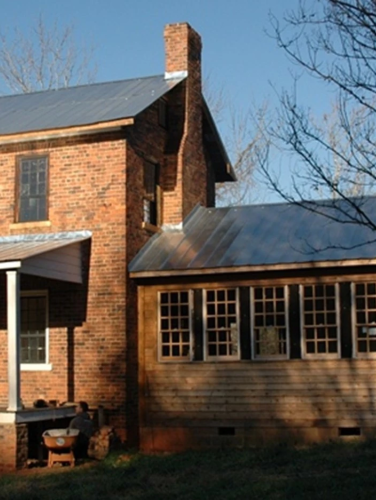
Oehler House
(ca. 1852)
The Oehler House is Mecklenburg County’s only known “I-house” styled home constructed of brick.
14401 Huntersville-Concord Rd, Huntersville, NC 28078
Born in Baden-Württemberg, Germany, George Martin Oehler (1815-1871) was one of a large group comprised of at least six related Oehler families, all descended from Johann Georg Oehler and Maria Magdalena Leonhardt, to immigrate to northern Mecklenburg County and southern Cabarras County in the early 1840s. He married Elizabeth Baldwin Thomasson (1816-1883), a native of Mecklenburg County, in January 1841, and the couple settled in the Ramah community in the northwestern section of the county.
Property Quick Links
In 1852, George purchased 250 acres from Caleb Erwin, a wealthy planter and well-known figure in Mecklenburg County who owned almost 800 acres in Ramah. There, George built an impressive and unusual farmhouse for his growing family that, by then, included seven young children. The Oehler House is distinctive in its unique combination of German building practices and the regional vernacular "I-house" building style. Although the "I-house" plan was one of the most popular forms for rural residents during the 19th century, the vast majority of I-houses throughout North Carolina were wood frame construction covered with wooded clapboards. The Oehler House is the only known I-house constructed of brick in the county.
The Oehler family farmed the land, eventually cultivating over ninety of the 250 acres they owned. They grew corn, wheat, oats, and cotton as primary cash crops, as well as a variety of vegetables in their kitchen garden. The family also raised cattle, hogs, and sheep. Like most farming families in Mecklenburg County, the Oehlers owned no enslaved persons. But unlike most of those families, for whom slave ownership was a financial impossibility rather than a moral or ethical issue, the Oehlers (and especially George) were staunchly opposed to slavery. The Oehlers instead employed two teenage boys (Martin and John) as farm hands and one young female laborer (Elizabeth) to help Elizabeth Oehler and her daughters with household chores and gardening. The three workers lived on the farm with the Oehler family.
The Oehlers became important figures within the social and religious spheres of the Ramah Community. George Oehler became an elder of Ramah Presbyterian Church in 1856 and remained a prominent member of the congregation until shortly after the Civil War, when he was suspended by church elders because of his “Northern sympathies.” Despite that suspension, the Oehler family remained in the community and continued life on their farm. They were eventually welcomed back into Ramah Presbyterian Church, where George and Elizabeth worshiped until their deaths. George predeceased Elizabeth, leaving her and their son Milas (1853-1935) to run the farm with the help of tenants and farmhands. After Elizabeth’s death, Milas took over ownership of the farm and a majority of the land. Although Milas continued to farm the property, living in the house with his wife, Susan Morrison Oehler (1867-1920), their five children, and several relatives, his interest in farming dwindled as his interest in gold increased. Finally, in the early 1920s, Milas (then in his sixties) abandoned the farm and headed west to look for gold. Other Oehler family members drifted into and out of the Oehler House, until Milas returned briefly in 1926 to mortgage the family homestead to a man named Wash Davis. The property, including the house and approximately 160 acres, was sold in 1945.

